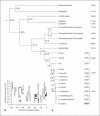Gorilla and orangutan brains conform to the primate cellular scaling rules: implications for human evolution
- PMID: 21228547
- PMCID: PMC3064932
- DOI: 10.1159/000322729
Gorilla and orangutan brains conform to the primate cellular scaling rules: implications for human evolution
Abstract
Gorillas and orangutans are primates at least as large as humans, but their brains amount to about one third of the size of the human brain. This discrepancy has been used as evidence that the human brain is about 3 times larger than it should be for a primate species of its body size. In contrast to the view that the human brain is special in its size, we have suggested that it is the great apes that might have evolved bodies that are unusually large, on the basis of our recent finding that the cellular composition of the human brain matches that expected for a primate brain of its size, making the human brain a linearly scaled-up primate brain in its number of cells. To investigate whether the brain of great apes also conforms to the primate cellular scaling rules identified previously, we determine the numbers of neuronal and other cells that compose the orangutan and gorilla cerebella, use these numbers to calculate the size of the brain and of the cerebral cortex expected for these species, and show that these match the sizes described in the literature. Our results suggest that the brains of great apes also scale linearly in their numbers of neurons like other primate brains, including humans. The conformity of great apes and humans to the linear cellular scaling rules that apply to other primates that diverged earlier in primate evolution indicates that prehistoric Homo species as well as other hominins must have had brains that conformed to the same scaling rules, irrespective of their body size. We then used those scaling rules and published estimated brain volumes for various hominin species to predict the numbers of neurons that composed their brains. We predict that Homo heidelbergensis and Homo neanderthalensis had brains with approximately 80 billion neurons, within the range of variation found in modern Homo sapiens. We propose that while the cellular scaling rules that apply to the primate brain have remained stable in hominin evolution (since they apply to simians, great apes and modern humans alike), the Colobinae and Pongidae lineages favored marked increases in body size rather than brain size from the common ancestor with the Homo lineage, while the Homo lineage seems to have favored a large brain instead of a large body, possibly due to the metabolic limitations to having both.
Copyright © 2011 S. Karger AG, Basel.
Figures






Similar articles
-
Cellular scaling rules for the brains of an extended number of primate species.Brain Behav Evol. 2010;76(1):32-44. doi: 10.1159/000319872. Epub 2010 Sep 30. Brain Behav Evol. 2010. PMID: 20926854 Free PMC article.
-
Not all brains are made the same: new views on brain scaling in evolution.Brain Behav Evol. 2011;78(1):22-36. doi: 10.1159/000327318. Epub 2011 Jun 17. Brain Behav Evol. 2011. PMID: 21691045 Review.
-
Cellular Scaling Rules for the Brains of Marsupials: Not as "Primitive" as Expected.Brain Behav Evol. 2017;89(1):48-63. doi: 10.1159/000452856. Epub 2017 Jan 27. Brain Behav Evol. 2017. PMID: 28125804
-
Cellular scaling rules for primate brains.Proc Natl Acad Sci U S A. 2007 Feb 27;104(9):3562-7. doi: 10.1073/pnas.0611396104. Epub 2007 Feb 20. Proc Natl Acad Sci U S A. 2007. PMID: 17360682 Free PMC article.
-
Hominin life history: reconstruction and evolution.J Anat. 2008 Apr;212(4):394-425. doi: 10.1111/j.1469-7580.2008.00867.x. J Anat. 2008. PMID: 18380863 Free PMC article. Review.
Cited by
-
The remarkable, yet not extraordinary, human brain as a scaled-up primate brain and its associated cost.Proc Natl Acad Sci U S A. 2012 Jun 26;109 Suppl 1(Suppl 1):10661-8. doi: 10.1073/pnas.1201895109. Epub 2012 Jun 20. Proc Natl Acad Sci U S A. 2012. PMID: 22723358 Free PMC article. Review.
-
The uniqueness of the human brain: a review.Dement Neuropsychol. 2024 Apr 15;18:e20230078. doi: 10.1590/1980-5764-DN-2023-0078. eCollection 2024. Dement Neuropsychol. 2024. PMID: 38628563 Free PMC article. Review.
-
First Bites-Why, When, and What Solid Foods to Feed Infants.Front Pediatr. 2021 Mar 26;9:654171. doi: 10.3389/fped.2021.654171. eCollection 2021. Front Pediatr. 2021. PMID: 33842413 Free PMC article. Review.
-
Acute Ethanol Increases IGF-I-Induced Phosphorylation of ERKs by Enhancing Recruitment of p52-Shc to the Grb2/Shc Complex.J Cell Physiol. 2017 Jun;232(6):1275-1286. doi: 10.1002/jcp.25586. Epub 2016 Dec 19. J Cell Physiol. 2017. PMID: 27607558 Free PMC article.
-
Mode of genetic inheritance modifies the association of head circumference and autism-related symptoms: a cross-sectional study.PLoS One. 2013 Sep 18;8(9):e74940. doi: 10.1371/journal.pone.0074940. eCollection 2013. PLoS One. 2013. PMID: 24058641 Free PMC article. Clinical Trial.
References
-
- Azevedo FA, Carvalho LR, Grinberg LT, Farfel JM, Ferretti RE, Leite RE, Jacob Filho W, Lent R, Herculano-Houzel S. Equal numbers of neuronal and nonneuronal cells make the human brain an isometrically scaled-up primate brain. J Comp Neurol. 2009;513:532–541. - PubMed
-
- Bonner JT. Why size matters: from bacteria to blue whales. Princeton: Princeton University Press; 2006.
-
- Byrne RW. The Thinking Ape: Evolutionary Origins of Intelligence. Oxford: Oxford University Press; 1995.
-
- Conroy GC. Primate Evolution. New York: WW Norton; 1990.
-
- de Sousa A, Woods B. The hominin fossil record and the emergence of the modern human central nervous system. In: Kaas J, editor. Evolution of Nervous Systems: A Comprehensive Reference. vol 4. Oxford: Elsevier; 2007.
Publication types
MeSH terms
Substances
Grants and funding
LinkOut - more resources
Full Text Sources

